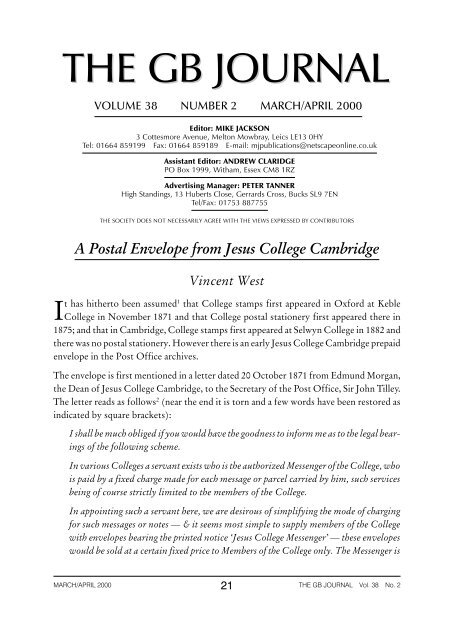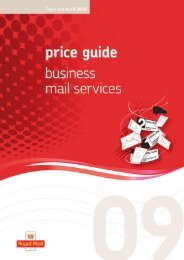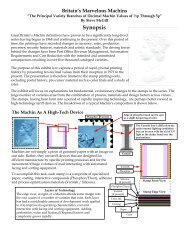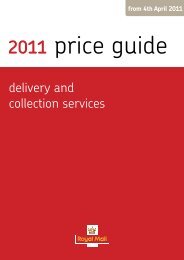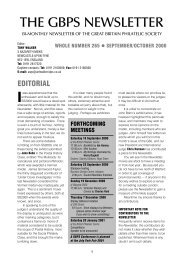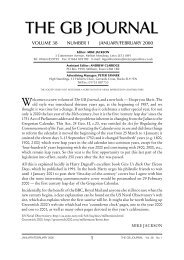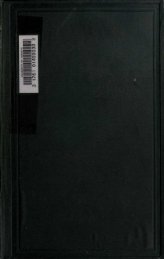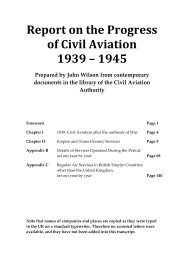Volume 38 Number 2 - Great Britain Philatelic Society
Volume 38 Number 2 - Great Britain Philatelic Society
Volume 38 Number 2 - Great Britain Philatelic Society
You also want an ePaper? Increase the reach of your titles
YUMPU automatically turns print PDFs into web optimized ePapers that Google loves.
THE GB JOURNAL<br />
VOLUME <strong>38</strong> NUMBER 2 MARCH/APRIL 2000<br />
Editor: MIKE JACKSON<br />
3 Cottesmore Avenue, Melton Mowbray, Leics LE13 0HY<br />
Tel: 01664 859199 Fax: 01664 859189 E-mail: mjpublications@netscapeonline.co.uk<br />
Assistant Editor: ANDREW CLARIDGE<br />
PO Box 1999, Witham, Essex CM8 1RZ<br />
Advertising Manager: PETER TANNER<br />
High Standings, 13 Huberts Close, Gerrards Cross, Bucks SL9 7EN<br />
Tel/Fax: 01753 887755<br />
THE SOCIETY DOES NOT NECESSARILY AGREE WITH THE VIEWS EXPRESSED BY CONTRIBUTORS<br />
A Postal Envelope from Jesus College Cambridge<br />
Vincent West<br />
It has hitherto been assumed1 that College stamps first appeared in Oxford at Keble<br />
College in November 1871 and that College postal stationery first appeared there in<br />
1875; and that in Cambridge, College stamps first appeared at Selwyn College in 1882 and<br />
there was no postal stationery. However there is an early Jesus College Cambridge prepaid<br />
envelope in the Post Office archives.<br />
The envelope is first mentioned in a letter dated 20 October 1871 from Edmund Morgan,<br />
the Dean of Jesus College Cambridge, to the Secretary of the Post Office, Sir John Tilley.<br />
The letter reads as follows 2 (near the end it is torn and a few words have been restored as<br />
indicated by square brackets):<br />
I shall be much obliged if you would have the goodness to inform me as to the legal bearings<br />
of the following scheme.<br />
In various Colleges a servant exists who is the authorized Messenger of the College, who<br />
is paid by a fixed charge made for each message or parcel carried by him, such services<br />
being of course strictly limited to the members of the College.<br />
In appointing such a servant here, we are desirous of simplifying the mode of charging<br />
for such messages or notes —&itseems most simple to supply members of the College<br />
with envelopes bearing the printed notice ‘Jesus College Messenger’ — these envelopes<br />
would be sold at a certain fixed price to Members of the College only. The Messenger is<br />
MARCH/APRIL 2000 21 THE GB JOURNAL Vol. <strong>38</strong> No. 2
A POSTAL ENVELOPE FROM JESUS COLLEGE CAMBRIDGE<br />
not retained for this service specially, but has many other duties wh: render him very(?)<br />
strictly a domestic servant — he would however deliver these as part of his duty.<br />
Usually if one has to send a note in the Town a fee must perforce be paid to the bearer.<br />
I wish then to know whether such services (wh: are closely analogous to those rendered<br />
by Commissionairs) infringe in any way the patent of the Post Office.<br />
Let me hope that while saying this I have made it plain that the Messenger is paid a fixed<br />
salary per week, that he has man[y] other duties, & that the fee proposed is r[ather?] to<br />
check Undergrad[uates] in undue use of [the?] services than any purpose of making a<br />
gain from his services.<br />
Is it legal to do this?<br />
A reply at your earliest convenience will much oblige [the] College Authorities.<br />
[The] Post Master in [Cam]bridge advised my direct application to you.<br />
The letter was passed to the Solicitor Mr Ashurst for his opinion, who replied to the<br />
Secretary on the 26th as follows 3 :<br />
The case put by the Writer of the enclosed letter seems to be this:-<br />
The College authorities employ a Servant and they propose to charge the Members of the<br />
College, (by selling to them a particular form of envelope,) a certain sum in respect of<br />
every letter of such Members conveyed and delivered by that Servant — possibly making<br />
a profit by the transaction.<br />
Such a transaction would seem to be all but identical with that pursued by the Circular<br />
Delivery Company a few years ago, which was declared by the Court of Queens Bench<br />
to be illegal — and I think the applicant should be so informed.<br />
Despite this opinion a reply was sent, on the Secretary’s instructions, to the Dean on<br />
31 October ‘that the delivery of the letters in question by the servant of the Colleges of<br />
Cambridge University [illegible] indicated by him would not appear to be an infringement of<br />
the Postmr. General’s monopoly in regard to the collection conveyance delivery of letters’.No<br />
reason for this decision is recorded and it confused the Cambridge Postmaster J. H. Turner<br />
when the papers were sent to him for information soon after. He asked for confirmation<br />
that a clerical error had not been made and this was given on 2 November. A Post Office<br />
memorandum dated 1 June 1885 4 suggests ‘possibly because no collection of letters was<br />
mentioned, [the Secretary] regarded this case as one of a delivery by a Messenger sent on<br />
purpose’, which was allowed by the Post Office Acts. Perhaps also the Universities, having<br />
THE GB JOURNAL Vol. <strong>38</strong> No. 2 22 MARCH/APRIL 2000
A POSTAL ENVELOPE FROM JESUS COLLEGE CAMBRIDGE<br />
Fig. 1 (actual size)<br />
enjoyed postal privileges for centuries, were recognised on further reflection as being a<br />
quite different case from the Circular Delivery Companies.<br />
No specimen of the envelope was enclosed with the Dean’s letter but just one is enclosed<br />
with the 4 April 1885 report from Charles Rea, the Surveyor of the Eastern District on the<br />
Cambridge College messenger systems 5 which says ‘At Jesus a distinctive envelope is used,<br />
which costs 1d. — specimens enclosed’. This suggests that the envelope may have been in use<br />
till at least 1885 (the College stamps and stationery were suppressed in 1886).<br />
The unused envelope in the Post Office archives (Fig. 1) has ‘Jesus College Messenger.’<br />
across the face at the top in black and is embossed in colourless relief with a garter on the<br />
flap. It is in cream laid unwatermarked paper, with the laid lines running diagonally across<br />
its face, and measures 7 . 8cmx13 . 4cm(3 1 8 in. x 5 1 4 in.). The words ‘1 d . charged for this’ and a<br />
Post Office reference number ‘35.762’ have been written on its face. Two holes have been<br />
punched in it (to invalidate it?) and there is also a hole for the tag which holds it in its file.<br />
There is no example of the envelope in the archives of Jesus College, but in the College<br />
‘Conclusion Book’ 6 (containing brief minutes of the decisions of meetings, mostly<br />
MARCH/APRIL 2000 23 THE GB JOURNAL Vol. <strong>38</strong> No. 2
A POSTAL ENVELOPE FROM JESUS COLLEGE CAMBRIDGE<br />
relating to College property) for 1 November 1871 it was resolved that a college<br />
messenger be appointed ‘with a competent wage’.<br />
Acknowledgements<br />
I am grateful for assistance from the staff of Post Office Heritage, Chris Harman and<br />
Dr F. H. Willmoth of Jesus College. The quotations and illustration from Post Class<br />
30-502 are reproduced by kind permission of The Post Office.<br />
References<br />
1. See for example Lister, R., College Stamps of Oxford and Cambridge, 2nd<br />
edition, 1974.<br />
2. Post Class 30-502D, File I.<br />
3. Post Class 30-502D, File I.<br />
4. Post Class 30-502D, File V, memorandum enclosed with Post Office minute<br />
1885/6422 to the Postmaster General.<br />
5. Post Class 30-502D, File IV.<br />
6. Classmark COL 4.4 <br />
QV 3d Jubilee on Orange Paper — Date of Issue<br />
Raymond Abela<br />
Ihave recently bought a fine used copy of the<br />
Jubilee 3d purple on orange paper. The stamp<br />
bears a clear Rugby c.d.s. of 22 October 1889. As<br />
the SG Specialised Catalogue (11th edition) list the<br />
stamp’s earliest known use as 1891, I thought this<br />
would be worth reporting in The GB Journal. The<br />
stamp was bought from a well-known reputable<br />
GB dealer who advertises regularly in the GBJ.<br />
THE GB JOURNAL Vol. <strong>38</strong> No. 2 24 MARCH/APRIL 2000
Neale’s Steam Press Experiment 1854–1856<br />
W. de L. M. Messenger<br />
This article supersedes my articles on the steam press trials published in The GB<br />
Journal, Vol. 26, pp. 95–96 and Vol. 27, pp. 34–35). It results from further<br />
information of which I have since become aware (and from further thought!).<br />
It follows an article by David Rowse in the London Philatelist (Vol. 106, pp. 321–336,<br />
Vol. 107, pp. 11–14) which provides a comprehensive chronological survey of the<br />
contractual, financial, and legal background of the experiments, together with<br />
biographical information about Robert Neale, J. B. Bacon and others involved with the<br />
steam press, but is less concerned with philatelic matters. It is on the latter that my<br />
attention has been focused. I believe I have identified at least eight successive trials of the<br />
steam press, using up to twelve different plates.<br />
As Mr Rowse points out, the records are sketchy because J. B. Bacon was anxious to gain<br />
advantage over his competitors by restricting knowledge of the trials. In consequence<br />
most of the correspondence was carried on from his own house and little of it has been<br />
found among the firm’s records. Sir E. D. Bacon, in his account of the printing of the<br />
line-engraved stamps, has only two paragraphs (pp. 144 and 145) giving no further<br />
information than is contained in five letters reproduced in his Appendix C.<br />
It should be appreciated that the essence of Neale’s invention was not the use of steam<br />
power, but the press itself which could be driven by a steam engine or by any other prime<br />
mover.<br />
Neale’s First Machine<br />
From a drawing in the patent specification (AD 1853 January 15 No. 120), reproduced by<br />
Rowse (LP 106/322), Neale’s first machine appears to have carried three printing plates on<br />
endless chains, being inked, wiped and printed from in succession. It seems that these<br />
plates were much smaller than the postage plates and did not print stamps. Plain,<br />
unwatermarked paper was used. The description appears to have been added later to the<br />
drawing reproduced by Rowse, since it relates to a view from the other side of the machine<br />
and does not refer to the lettering on the drawing.<br />
1st Trial<br />
Neale’s first trial was on 6 January 1854; the machine proved unsatisfactory.<br />
MARCH/APRIL 2000 25 THE GB JOURNAL Vol. <strong>38</strong> No. 2
NEALE’S STEAM PRESS EXPERIMENT 1854–1856<br />
2nd Trial<br />
A second trial on 25 February was regarded by J. B. Bacon as more successful. There had<br />
been no official involvement of the Board so far.<br />
2nd Machine (‘No. 1’) — (and 3rd, 4th and 5th)<br />
Notwithstanding problems with the first machine, it was agreed that four more, improved,<br />
machines should be ordered, the first of which was erected at Perkins, Bacon’s works on<br />
6 March 1855. These machines were to use the official postage plates. It is possible that the<br />
description attached to the illustration reproduced by Rowse (LP 106/322) relates to these<br />
improved new machines, which must have been much wider than the first machine in order<br />
to accommodate the unusually long postage plates, almost certainly mounted across the<br />
direction of travel. From the sketchy information available about the plates used it seems<br />
likely that the machine normally worked with two plates at a time.<br />
3rd Trial<br />
On 2 April 1855, Perkins, Bacon wrote to Ormond Hill (Bacon’s App. C (197))<br />
announcing that they had ‘secured a patent for machinery for printing from engraved plates by<br />
means of mechanical instead of hand power ...’<br />
They requested permission to test the machine by printing stamps from one of the postage<br />
plates before it was registered, on paper markedly different from that in current use. The<br />
impressions could be taken in charge and destroyed by the Board’s Officer.<br />
The Board’s regular officer was stationed on the floor below the drying room (which was<br />
at the top of the building) but (presumably because the new machine and its driving engine<br />
were installed on the ground floor) it was suggested that the Board might prefer to appoint<br />
another Officer specially for the purpose of the trials; the firm would be prepared to meet<br />
the cost of his attendance. They expected to begin the following Thursday morning<br />
(5 April — not the 6th as stated by Rowse).<br />
Plates 16 and 17<br />
At the date of the letter the only unregistered plates in existence were the Die 2 Alphabet 2<br />
Plates 14 and 15, which had been finished on 24 and 29 March respectively. Plate 16 was<br />
finished on 4 April, the day before the proposed trial, but was still without its marginal<br />
inscriptions (Bacon’s App. G). Was this because it was earmarked for the trials?<br />
THE GB JOURNAL Vol. <strong>38</strong> No. 2 26 MARCH/APRIL 2000
NEALE’S STEAM PRESS EXPERIMENT 1854–1856<br />
It was not until the proposed starting date (5 April) that Thomas Keogh replied agreeing to<br />
the firm’s request (Bacon’s App. C (198)). The Superintendent of Postage Stamps would<br />
send someone specially to take charge of the plate, to receive all impressions and to take<br />
them to Somerset House for destruction. However the trial does not seem to have taken<br />
place on the date proposed, but a revised date is not mentioned in the known<br />
correspondence; the firm may have had to wait until the additional Officer could be sent<br />
(it would seem optimistic to have given officialdom only three days’ notice).<br />
Meanwhile plate production continued:<br />
Dates Plates finished<br />
April 4 16 — without legend<br />
1855 – April 18 17<br />
April 21 18<br />
May 7 16 – addition of legend<br />
May 8 19<br />
May 12 20<br />
On 30 April Bacon reported that the first machine of the new batch of four was in<br />
operation, the second erected but unfinished, and he had cancelled the order for<br />
completion of the third and fourth (Rowse, LP 106/330).<br />
There seems to have been a change of plan — to use registered plates. On the day Plate 20<br />
was finished (12 May), all seven Plates 14 to 20 were registered (Wright & Creeke, p. 244),<br />
and on 15 May Plates 16 and 17 were put to the steam press (W&C, pp. 33 & 244). This<br />
seems to have been the eventual date of the third test.<br />
Plate 18<br />
4th Trial<br />
A few weeks later, on 1 June, a third plate, Plate 18, was taken for the trials (W&C, pp. 34 &<br />
244). Could this mean there were now three plates mounted in the steam press? Stanley<br />
Gibbons lists imperforate stamps from this plate on Large Crown Paper (C6j).<br />
Ungummed imperforate singles and blocks have been reported by Tonna (GBJ 14/27) and<br />
by Barrell (GBJ 24/34), all of which could have come from the right half of a single sheet<br />
MARCH/APRIL 2000 27 THE GB JOURNAL Vol. <strong>38</strong> No. 2
NEALE’S STEAM PRESS EXPERIMENT 1854–1856<br />
divided vertically i.e. except for the single ‘PH’ reported by Barrell and illustrated by<br />
Tonna in The Plating of Alphabet II (which, unlike the rest, is gummed, so it may be from<br />
another sheet). This the first indication that official watermarked paper may have been<br />
used in the experiments.<br />
Plate 21<br />
Plate 21 was registered on 8 June 1855 and, according to Wiggins (PSGB 2/65, repeated by<br />
Stanley Gibbons, p. 170) put to press the same day — exactly a week after Plate 18 was put<br />
to the steam press. Was Plate 21 in fact paired with Plate 18 on that press? According to<br />
Wright and Creeke (p. 244) it was not put to the hand press until much later, on<br />
19 October, at the same time as Plate 20. This latter date is supported by a first recorded<br />
use on 16 December (Robson Lowe, GBJ 1/85).<br />
5th Trial<br />
Plate 22<br />
Wright and Creeke recorded in their ‘Tabular Statement’ (p. 244) (but not in their main<br />
text, as they did Plates 16, 17 and 18) that Plate 22 was first used in the steam press trials on<br />
1 August 1855. (It was registered on 8 June — not 18 August as stated by Rowse<br />
(LP 106/330)).<br />
Demonstration<br />
A whole imperforate ungummed sheet of Plate 22 was purchased in America by Robson<br />
Lowe in 1957. An illustration of it appears as a frontispiece to Tonna’s Penny Red Stars, Part<br />
2 (ed. Don Madden) and is reproduced here as Fig. 1. It bears a manuscript inscription in<br />
the bottom margin: ‘This sheet is one of 2000 printed by Mr. Neale’s machine for us this day<br />
August 15 1855 Perkins Bacon & Co.’ and down the left side in the same hand in French:<br />
‘Cette feuille est une de 2000 imprimé par la machine de M. Neale pour nous ce jour le 15 Aout<br />
1855 Perkins Bacon & Co.’ (‘imprimé’ should have been ‘imprimées’ to agree with ‘2000<br />
[feuilles]’ and ‘Aout’ should have a circumflex accent thus: ‘Août’). These inscriptions<br />
would appear to be the work of a member of the firm who knew some French — or perhaps<br />
J. B. Bacon’s daughter Sarah, who was his amanuensis. Latto (GBJ 6/67), illustrates a<br />
corner block AA/FF + GA-GC from the same sheet.<br />
Wiggins (PSGB 2/77) reports only the English inscription, and without the firm’s<br />
‘signature’. He says there were inscriptions in all four margins, twice in each language. Latto<br />
THE GB JOURNAL Vol. <strong>38</strong> No. 2 28 MARCH/APRIL 2000
NEALE’S STEAM PRESS EXPERIMENT 1854–1856<br />
Fig. 1 — The imperforate ungummed sheet of Plate 22 which<br />
was purchased in America by Robson Lowe in 1957.<br />
MARCH/APRIL 2000 29 THE GB JOURNAL Vol. <strong>38</strong> No. 2
NEALE’S STEAM PRESS EXPERIMENT 1854–1856<br />
(GBJ 6/66) repeats this. Could they be referring to a different sheet, or is this merely an<br />
inadvertent slip?<br />
The words ‘for us’ and ‘pour nous’ in these inscriptions and the use of two languages<br />
suggest that the printing of 2,000 sheets on 15 August was a demonstration before invited<br />
spectators, the culmination of trials to date. The fact that the sheet reached New York<br />
tends to support this view (Perkins, a founder member of Perkins, Bacon & Petch, then<br />
dead, was an American who, before the advent of the postage stamp, had brought over<br />
other Americans to this country to engage in security printing.) Regrettably this sheet was<br />
broken up and pieces sold in 1957. (The back of the Robson Lowe GB sale catalogue for<br />
6 November 1957 carried a Regent Stamp Co. Ltd private treaty advertisement for the<br />
remaining pieces: ‘a Fellow of the Royal <strong>Philatelic</strong> <strong>Society</strong> purchased the entire sheet, kept that<br />
portion that he wanted for his own collection and returned the balance to us for sale’).<br />
Wiggins (PSGB 2/77) says of Plate 22: ‘Centring is often unkind and must have left many<br />
stamps [i.e. sheets] being discarded’, i.e. perforation was difficult: it might not have been<br />
thought worthwhile, after the trial, to print more sheets from the plate on a hand press, as<br />
Wright and Creeke report for Plates 16, 17 and 18. They mention no corresponding usage<br />
for Plate 22, which is recorded as having printed only 7,000 sheets. If 2,000 of them were<br />
printed on 15 August, the balance of 5,000 could easily have been printed between the 1st<br />
and 15th.<br />
There seems a strong possibility that Plate 22 was never used on a hand press and that all<br />
known stamps from it were printed on the steam press.<br />
Plate 25<br />
Stanley Gibbons’ Specialised Catalogue (p. 174) states that both Plates 22 and 25 were used<br />
‘for an experiment on Neal’s [sic, without the second ‘e’]steam press and are ungummed’.<br />
When I asked about what evidence there was for Plate 25 I was referred to Robson Lowe’s<br />
The British Postage Stamp, page 156 which says: ‘In August 1855 the printers made an<br />
experimental printing with a steam-driven press, in a deep red-brown shade on deeply toned<br />
paper and this is represented [in the R. M. Phillips Collection] by an imperforate block of<br />
twenty-seven from plate 22 (28) as well as two smaller pieces. 2 There are also imperforate<br />
marginal blocks of eight and four2 from plate 25 (33)’. The superscript ‘2’ (in two places)<br />
refers to a footnote ‘See illustrations in colour on page 13 of imperforate blocks of four from<br />
plates 22 and 25.’ (These illustrations will be referred to later).<br />
At first glance this extract seems to support the view that Plate 25 was also used in the<br />
trials, but more careful consideration shows that it does not.<br />
THE GB JOURNAL Vol. <strong>38</strong> No. 2 30 MARCH/APRIL 2000
NEALE’S STEAM PRESS EXPERIMENT 1854–1856<br />
On the other hand, the late Mr Robson Lowe in a letter to myself dated 28 November<br />
1988, in which he gives the provenance of the Plate 22 sheet already described here, wrote<br />
‘Curiously enough, in 19<strong>38</strong> we acquired a half-sheet of the same variety from plate 25’.<br />
Wiggins (PSGB 2/80) describes this imperforate half-sheet, but does not attribute it to the<br />
steam press. Mr Robert Folkard has kindly sent me a photocopy of it mounted on an album<br />
page, that he acquired from Robson Lowe in the 1960s. The page was annotated to the<br />
effect that the half-sheet was discovered in New York. It is an upper half. The sheet margin<br />
has no manuscript inscriptions or other indications that it came from the steam press, and<br />
the album page heading states that the plate was put to press in November 1855 — Wright<br />
and Creeke (p. 244) say 12 November, the same day as Plate 26 (the annotated Plate 22<br />
sheet was printed in August). The first recorded use of a stamp from Plate 25 is 8 February<br />
1856 — a typical two or three months after going to press in November. Sadly the<br />
half-sheet was cut up and sold in June 1939.<br />
Latto (GBJ 6/66) illustrated an unused imperforate block of six AA/CB from Plate 25<br />
which appears to have come from the aforementioned half-sheet. Wiggins & Tonna (The<br />
Plating of Alphabet III, MA to PL) show a block of four AG/BH.<br />
Here it is necessary to consider the significance of the quotations already given from<br />
Robson Lowe’s The British Postage Stamp and his letter of November 1988 with the phrase<br />
‘of the same variety’, which some have taken to link the Plate 25 half-sheet with the Plate<br />
22 whole sheet and hence have attributed the former to the steam press as well as the latter.<br />
Certainly both sheets are ‘of the same variety’ in so far as they are both in shades of<br />
red-brown on blued Large Crown paper and are ungummed and imperforate, but stamps<br />
with these characteristics in common may well be in different shades, or from different<br />
printings.<br />
Although the whole sheet of Plate 22 was described by Robson Lowe in The British Postage<br />
Stamp (p. 156) as being ‘in a deep red-brown shade on deeply toned paper’, in his letter to me<br />
of 28 November 1988 he said it was ‘almost orange-brown on toned paper’, exactly the same<br />
wording as in the 1957 Regent Stamp Co. private treaty advertisement for pieces from the<br />
sheet. Beaumont (GBJ 3/14) describes the piece HD/JG from it as in ‘deep red brown on<br />
blued paper’ and Folkard, in a letter to myself dated 20 October 1997, describes the<br />
re-joined piece GH/II as in ‘red brown/orange brown’ on ‘blued paper’. He adds that the<br />
colour might be described as ‘orange brown although not a distinctive shade’.<br />
However, it must be remembered that the red-brown ink was chosen because it was more<br />
fugitive under chemical attack than the new black cancelling ink. Robson Lowe says, in the<br />
letter to myself already quoted, that the Plate 22 sheet had been framed and hung in the hall<br />
MARCH/APRIL 2000 31 THE GB JOURNAL Vol. <strong>38</strong> No. 2
NEALE’S STEAM PRESS EXPERIMENT 1854–1856<br />
of the Chase National Bank in New York ‘as long as anyone could remember’. Thus one<br />
cannot be sure that exposure to light and city air pollution have not altered the colour since<br />
the sheet was printed.<br />
Page 13 of Robson Lowe’s The British Postage Stamp has coloured reproductions, side by<br />
side, of the R. M. Phillips blocks of four from the Plate 22 sheet (KD/LG) and the Plate 25<br />
half-sheet (DK/EL) referred to in the footnote 2 to page 156, already cited. They actually<br />
are not of the same shade, the former being the darker, so that it is difficult to believe that<br />
they are from the same printing. One might attribute the difference to dissimilar<br />
conditions of photography. However both blocks are in <strong>Volume</strong> XXII of the R. M. Phillips<br />
Collection and were presumably photographed on the same occasion and under identical<br />
conditions.<br />
There also seems disagreement as to whether the paper of the Plate 22 stamps is ‘toned’ or<br />
‘blued’. Although ‘toned’ in connection with the QV line-engraved stamps is generally<br />
applied to paper with a yellowish tinge, it could equally well be applied to the slightly blued<br />
papers. Here again the blue colour seems not to be stable, as Madden has pointed out in, for<br />
example, Tonna’s Penny Red Stars, Part 2 (pp. 4, 5). It is possible that the uncontrolled<br />
reaction between the ink and any conditioning agent applied to the paper may not have<br />
reached its end-point for many years. It may also be observed that toned (yellowish) paper<br />
is supposed not to have appeared until January 1857 — 15 months after the Plate 22<br />
printing.<br />
That the whole sheet of Plate 22 and the half-sheet of Plate 25 were not from the same<br />
printing is confirmed by the facts that the former was printed on 15 August, while the<br />
latter plate was not registered until 12 November 1855 and, with Plate 26, was put to the<br />
hand press in the normal way on that same day.<br />
That both sheets were found in New York may be merely coincidental — the two finds<br />
were 19 years apart.<br />
6th Trial<br />
On 31 October, J. B. Bacon finally cancelled the order for the last two machines of the<br />
batch of four (Rowse, LP 106/330). Nevertheless Neale agreed on 20 November to try the<br />
first of these machines for three days, requesting inks and men to assist him. This request<br />
appears not to have included plates. Plate 17 reverted to hand printing on 30 November,<br />
but Plates 16 and 18 did not do so until 17 December — were they still with the steam press<br />
and had Neale been intending to use them? Other doubtful possibilities are Plates 21 and<br />
22.<br />
THE GB JOURNAL Vol. <strong>38</strong> No. 2 32 MARCH/APRIL 2000
NEALE’S STEAM PRESS EXPERIMENT 1854–1856<br />
On 7 December, Neale reported that he had carried on the trial for four days, but Bacon<br />
wrote to him on the same day that it had been ‘quite unsatisfactory’ (Rowse, LP 106/331).<br />
Reversion of Plates to Hand Presses<br />
In the normal course of events, had they not been taken for the steam press trials, Plates<br />
16, 17, and 18 would have been started on hand presses in October. Instead Plates 19 and<br />
20 went to press in that month and the three trial plates did not revert to hand working<br />
until six weeks later:<br />
Dates Plates to hand presses<br />
1855 October 16 19<br />
October 19 20<br />
November 30 17<br />
December 11 16, 18<br />
While the rest of the Die 2 Alphabet 2 plates were withdrawn before 8 May 1856, the last<br />
three, having started regular hand printing late, continued on hand presses beyond that<br />
date, just into the toned paper period (Wiggins, PSGB 2/58–62), not being destroyed until<br />
22 June 1857.<br />
(To be continued)<br />
PENNY PINK LETTER SHEETS<br />
Michael H. Lockton, FRPSL<br />
Introduction<br />
Mulready Letter Sheets were issued in May 1840 and withdrawn in April 1844. During<br />
the four years of availability, they were extensively used for commercial advertising,<br />
their format making them eminently suitable for printing on the reverse side. These<br />
printed letter sheets have been studied in great detail and are listed in Appendix 1 of the SG<br />
Specialised Catalogue1 and illustrated in The Mulready Advertisements2 . (The GBPS<br />
MARCH/APRIL 2000 33 THE GB JOURNAL Vol. <strong>38</strong> No. 2
PENNY PINK LETTER SHEETS<br />
Newsletter dated July/August 1999 (page 5) announced that Tom Slemons of the USA and<br />
Bill Barrell of H&B Philatelists are proposing to publish a new edition of this latter book).<br />
Penny Pink Letter Sheets<br />
In April 1844 the Mulready was replaced by the Penny Pink letter sheet3 printed on<br />
Dickinson’s threaded paper. Subsequently these letter sheets were printed on a further two<br />
qualities of this paper4 . A summary of these letter sheets is as follows:<br />
1844 LP3 Thick creamish white wove paper with threads.<br />
1846/50 LP4a Thin greyish white wove paper with threads.<br />
” LP4b Thin blue wove paper with threads.<br />
The author considers the description of the paper of Type LP4a is more accurate than that<br />
given in Ref 4.<br />
As with the Mulready, various institutions and companies used these letter sheets for<br />
advertising and for commercial transactions (invoices, statements, etc.). The author is<br />
unaware of any attempt to list these printed letter sheets in a similar manner to that of the<br />
Mulready and would like to attempt an initial listing.<br />
Two typical examples of printed Penny Pink letter sheets are shown in the accompanying<br />
figures. Figure 1 shows that of the Atlas Assurance Company — one of the more common<br />
examples. If one refers to the listing of the similar Mulready advertisement 1 , the following<br />
entry will be found:<br />
MA28 Atlas Assurance Company<br />
a. Dated: Cheapside, 21st Dec. 1839<br />
b. Dated: 92 Cheapside, 10th Oct. 1840 (9 lines of claims)<br />
ba. Dated: As b but 11 lines of claims.<br />
c. Dated: 92, Cheapside, 10th May 1841<br />
d. Dated: 92, Cheapside, 10th Oct. 1841<br />
e. Dated: 92, Cheapside, 11th Feb. 1842<br />
f. Dated: 92, Cheapside, 7th April 1842<br />
g. Dated: 92, Cheapside, June 1842<br />
h. Dated: 92, Cheapside, Nov. 1842<br />
i. Dated: 92, Cheapside, Aug. 1843<br />
Advert (i) exists on the 1d. pink stationery envelope [sic], with new directors’<br />
names etc.<br />
THE GB JOURNAL Vol. <strong>38</strong> No. 2 34 MARCH/APRIL 2000
PENNY PINK LETTER SHEETS<br />
Fig. 1 — Atlas Assurance Company letter sheet on LP4a.<br />
(Note address and date in bottom left corner).<br />
MARCH/APRIL 2000 35 THE GB JOURNAL Vol. <strong>38</strong> No. 2
PENNY PINK LETTER SHEETS<br />
Fig. 2 — Nissen & Parker letter sheet printed in green ink on LP3.<br />
THE GB JOURNAL Vol. <strong>38</strong> No. 2 36 MARCH/APRIL 2000
PENNY PINK LETTER SHEETS<br />
As will be seen from Figure 1, this particular example is dated in the bottom left corner<br />
‘92, Cheapside, 1st December, 1849’. At present the author has recorded five printings on<br />
Type LP4a:<br />
September 1848<br />
February 1849<br />
1 December 1849<br />
August 1850<br />
November 1850<br />
This information indicates a five year gap between the demise of the Mulready and the<br />
recorded printing on Penny Pinks. The question arises as to whether or not examples were<br />
printed on Type LP3 in this intervening period. Figure 2 is a typical advertising letter sheet<br />
of Nissen & Parker, <strong>Great</strong> Tower Street, London on Type LP3. This particular example is<br />
printed in green ink and was used from Ipswich to Liverpool on 23 October 1845. The<br />
author has also recorded an example printed in red ink.<br />
Appeal for information<br />
In order to commence the production of an initial listing of Penny Pink letter sheets, the<br />
author would be pleased to receive a photostat copy of any such sheets held by collectors.<br />
In addition, it would be useful to know whether the letter sheet is Type LP3, LP4a or LP4b<br />
and if postally used, the date and place of posting. Having supplied information in the past<br />
to similar appeals without as much as an acknowledgement, the author will ensure each<br />
response is acknowledged and that a subsequent article in The GB Journal will summarise<br />
the findings. Please note this initial listing will only include those printed on Post Office<br />
letter sheets, i.e. using Dickinson’s threaded paper. From 1855 with the introduction of<br />
stamped-to-order stationery, many firms produced printed letter sheets and wrappers but<br />
these fall outside the terms of reference of the present investigation.<br />
Please note the author’s new address: Wroxton, 10 Park Road, WOKING GU22 7BW.<br />
References<br />
1. Stanley Gibbons <strong>Great</strong> <strong>Britain</strong> Specialised Stamp Catalogue, <strong>Volume</strong> 1 Queen<br />
Victoria, 11th edn., 1997.<br />
2. Malcolm G. Lowe. The Mulready Advertisements. Mulready Research<br />
Foundation, California, USA, 1983.<br />
3. Michael H. Lockton. ‘Penny Pinks: The Date of Issue’, GBJ, Vol. 26, No. 5, p. 93.<br />
4. A. K. Huggins. British Postal Stationery. GBPS, 1970. <br />
MARCH/APRIL 2000 37 THE GB JOURNAL Vol. <strong>38</strong> No. 2
1940 Centenary Exhibition Miniature Sheets<br />
Pat Lyon<br />
For some time I have been trying to find out<br />
something about five stamps I have in my<br />
collection. I gave a display recently to my local<br />
society and showed the postcard and envelope,<br />
together with the Mulready caricature, which<br />
were issued for the Jubilee of Uniform Penny<br />
Postage in 1890. I also showed the miniature<br />
sheets of the Penny Black and 20p Machin, and<br />
the reproduction of the Penny Black and<br />
Twopenny Blue issued for the 150th anniversary<br />
exhibition. I had assumed that the centenary<br />
had not been celebrated in this way as it<br />
was during the war and, living in London at that<br />
time, I had not been aware of any exhibition.<br />
I also displayed the five stamps I mentioned at<br />
the beginning — all reproductions of the Penny<br />
Fig. 2<br />
Red (Fig. 1). Each of the five stamps is lettered<br />
D-K and is in a different colour: lilac; orange; green; dull red; and light brown — the latter<br />
having V-R in the top corners, the others having stars.<br />
I spoke to one of the members afterwards and he told me they may have been cut from<br />
some miniature sheets (Fig. 2) that he had obtained from an exhibition at Lancaster House<br />
in May 1940. His miniature sheets were in the same five colours as my stamps.<br />
What I would like to know is why the letters D-K were chosen, and also why the letters<br />
S-W were chosen for the 150th anniversary miniature sheet. I had never heard of these<br />
1940 centenary sheets before but I thought perhaps some of members may have. <br />
Fig. 1<br />
THE GB JOURNAL Vol. <strong>38</strong> No. 2 <strong>38</strong> MARCH/APRIL 2000
<strong>Number</strong>s in Maltese Cross — a ‘6’ or a ‘9’?<br />
Fig. 1 — ‘6’ in cross<br />
E. J. Mitchell<br />
Fig. 2 — ‘9’ in cross<br />
Generally, the numbered Maltese Cross cancellations ‘1’–‘12’, used at the London<br />
Chief Office from 1843–44, are readily distinguishable. A small cross on the outside<br />
indicates the top. This, providing it is visible, avoids confusion and in particular enables a<br />
‘6’ or a ‘9’ to be orientated correctly. Often, however, the top of the cross is poorly defined,<br />
or off the stamp, and correct orientation by this method is not possible.<br />
There are, however, clearly visible differences between the two crosses:<br />
The height of the ‘6’ is 5 . 5mm, whereas the ‘9’ is 5mm high.<br />
In the ‘6’ the enclosed circle tends towards an<br />
upright oval, as does the shape of the whole numeral,<br />
whereas the circle of the ‘9’, and the numeral itself, is<br />
more rounded.<br />
In the ‘6’ the vertical upright appears longer and<br />
extended upwards.<br />
The ‘9’ may appear daintier, and the top of the circle<br />
is often weak. <br />
Editor’s note: I happened to have a problem stamp which I<br />
had classified as a ‘6’ in cross. However, upon reading Mr<br />
Mitchell’s article I now think it is a ‘9’ — see Fig. 3. Fig. 3<br />
MARCH/APRIL 2000 39 THE GB JOURNAL Vol. <strong>38</strong> No. 2
Book Reviews<br />
COLLECTING BRITISH SQUARED CIRCLE POST-<br />
MARKS — SUPPLEMENT No. 4. Stanley F. Cohen,<br />
FRPSL; Maurice Barette, FRPSL; Daniel G. Rosenblat; A. M.<br />
Williams. Size A4, card covers, 63 pp. Published June 1999.<br />
No ISBN.<br />
This is the fourth supplement to Collecting British Squared<br />
Circle Postmarks, published by Stanley Cohen in 1987. Over<br />
1000 new updates are included, together with a listing of the<br />
‘Lonely <strong>Great</strong>s’ where only one copy has been recorded. In<br />
the provincial section Devonport, Gloucester and Ipswich are<br />
reviewed in some detail, and Maurice Barette has rewritten the<br />
section on the London WC office, showing for the first time<br />
the recut positions on the early SC hammers and the later CT<br />
hammers. Four collectors are acknowledged as having<br />
supplied the majority of the updates: Guy Grainger, John<br />
Hine, John Powell and Steven Reeve. This supplement is<br />
indispensable for those wishing to keep up to date with the<br />
definitive work on the subject.<br />
MJ<br />
STANLEY GIBBONS COLLECT CHANNEL ISLANDS<br />
AND ISLE OF MAN STAMPS, 16th edn. Size 195 x 165<br />
mm, soft-bound, 296 pp. Published 2000. Price £9 . 95. ISBN<br />
0-85259-482-8.<br />
Fully illustrated in black and white, this new edition of SG’s<br />
popular checklist of the islands has been revised and updated<br />
to include all stamp issues up to the end of 1999.<br />
MJ<br />
A REQUEST FOR ARTICLES — AND AN APOLOGY<br />
Short articles, long articles, notes, reviews, biographies, autobiographies, collecting<br />
techniques, hints and tips, criticism (constructive of course!), queries, replies —<br />
The GB Journal needs YOUR contribution.<br />
The apology is for the poor quality of some of the illustrations in the last issue:<br />
hopefully this will be remedied in this issue — MJ<br />
THE GB JOURNAL Vol. <strong>38</strong> No. 2 40 MARCH/APRIL 2000


